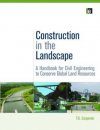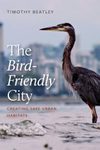![Construction in the Landscape Construction in the Landscape]()
Click to have a closer look
About this book
Contents
Customer reviews
Biography
Related titles
About this book
Construction in the Landscape describes the impact of construction on the land and landscape where it takes place. Geographical coverage is necessarily global to reflect the great variation both in people's economic and social needs and in the shortage or abundance of natural resources. Part I introduces both land resources, whether used for agriculture, human settlement or mineral extraction or conserved as scenery, wildlife habitat or for the undefined needs of future generations; and construction, its products, skills, processes and impacts on land resources.
Part II describes specific forms of civil engineering - from landform adaptation, through dams and river control works, coastal construction and transport infrastructure to particular types of structure such as bridges, towers and power stations, or the layout of complete settlements. Part III deals with regional planning of construction and land use in different geographical circumstances - from fine scenery, through rural countryside to city and suburban development - and to the sort of land arrangements that may be sustainable for an increased but hopefully more civilized human population a century hence.
Contents
Preface Part I: Land Resources 1. Land Features 2. The Impact of Construction Part II: Man-Made Forms and Structures 3. Landforms and their Modification 4. Earthworks for Structures 5. Mines and Quarries 6. Dams and Other Hydraulic Structures 7. Coastal and Estuarial Construction 8. Transport Routes and Infrastructure 9. Bridges and Crossings 10. Military and Industrial Construction 11. Towers 12. Buildings and Settlements Part III: Planning Construction in Various Landscapes 13. Construction in Scenic Country 14. Construction in Flat Open Country 15. Construction in Urban Landscapes 16. Built Landscapes in the Future Subject Index Index of Places and Projects
Customer Reviews
Biography
Tom Carpenter is a retired civil engineer with many years experience in planning a variety of construction projects in a wide range of physical situations in Asia, Africa and Europe. He is now a writer on natural resource and environmental aspects of construction.
By: T G Carpenter
544 pages, Colour plate section, photographs, figures
'This book answers the call from multidisciplinary landscape design professionals and students who are striving to create engineered landscapes that are not only sustainable, but optimized for all aspects of human and environmental requirements. The text focuses on the primary obligation of engineered landscapes to reach specified performance goals but couples this with the priority of the hydrological, ecological and aesthetic expectations necessary for sustainable landscape design. Overall, a first class text book for practitioners, researchers and students in civil engineering, and associated disciplines including planning, restoration ecology, hydrology and landscape design. ' Dr. Mark Simmons, Director of Research and Consulting at the Lady Bird Johnson Wildflower Center, University of Texas at Austin.


































